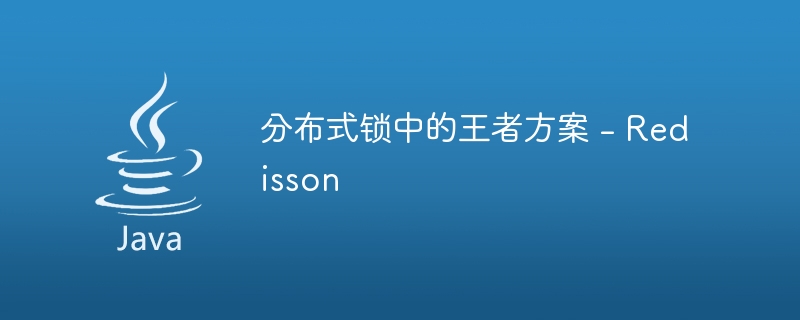 Backend Development
Backend Development PHP Tutorial
PHP Tutorial How to implement a distributed lock subscription and publishing system using PHP microservices
How to implement a distributed lock subscription and publishing system using PHP microservices
How to use PHP microservices to implement distributed lock subscription and publishing systems
Introduction:
With the widespread application of distributed systems, how to implement Distributed lock subscription and publishing systems have become an important topic. In PHP development, we can use microservice architecture to achieve this goal. This article will introduce how to use PHP microservices to build a distributed lock subscription and publishing system, and provide specific code examples.
1. The concept and application scenarios of distributed locks
Distributed lock is a mechanism used to solve the problem of resource competition in distributed systems. When multiple concurrent requests access a resource at the same time, by using distributed locks, it can be ensured that only one request can obtain permission for the resource, and other requests must wait for the resource to be released before accessing it. Distributed locks are widely used in various scenarios that require controlling concurrent access, such as cache updates, task scheduling, etc.
2. Overview of Microservice Architecture
Microservice architecture is an architectural pattern that splits an application into multiple small services, with each service running in an independent process. This model makes the application easier to maintain and expand, and enables independent deployment and horizontal expansion of services. In a microservices architecture, services collaborate by calling each other and passing messages.
3. Steps to implement distributed lock subscription and publishing system using PHP microservices
- Create the main service (publisher)
The main service is responsible Publish distributed lock information, and other services can obtain the latest distributed lock information by subscribing to the main service.
<?php
$context = new ZMQContext();
$socket = $context->getSocket(ZMQ::SOCKET_PUB);
$socket->bind("tcp://localhost:5555");
while (true) {
// 获取分布式锁信息,并发布到订阅者
$lockInfo = getLockInfo(); // 获取分布式锁信息的代码实现
$socket->send($lockInfo);
}- Create a subscription service (subscriber)
The subscription service is responsible for subscribing to the distributed lock information published by the main service and performing corresponding operations based on the lock information.
<?php
$context = new ZMQContext();
$socket = $context->getSocket(ZMQ::SOCKET_SUB);
$socket->connect("tcp://localhost:5555");
$socket->setSockOpt(ZMQ::SOCKOPT_SUBSCRIBE, "");
while (true) {
// 接收到发布的分布式锁信息
$lockInfo = $socket->recv();
// 根据锁信息执行相应的操作
if ($lockInfo == "acquire") {
// 执行获取锁的操作
acquireLock(); //获取分布式锁的代码实现
} elseif ($lockInfo == "release") {
// 执行释放锁的操作
releaseLock(); //释放分布式锁的代码实现
} else {
// 其他操作
}
}4. Summary
By using PHP microservice architecture, we can easily implement a distributed lock subscription and publishing system. The main service is responsible for publishing distributed lock information, and the subscription service is responsible for subscribing to lock information and performing corresponding operations. This distributed lock mechanism based on microservices can help us solve the problem of resource competition in distributed systems and improve the stability and scalability of the system.
The above is an introduction to how to use PHP microservices to implement a distributed lock subscription and publishing system, and also provides specific code examples. I hope this article will help you understand and apply distributed locks.
The above is the detailed content of How to implement a distributed lock subscription and publishing system using PHP microservices. For more information, please follow other related articles on the PHP Chinese website!
 分布式锁:5个案例,从入门到入土Aug 24, 2023 pm 02:48 PM
分布式锁:5个案例,从入门到入土Aug 24, 2023 pm 02:48 PM今天给大家分享的是分布式锁,本文使用五个案例、图、源码分析等来分析。常见的synchronized、Lock等这些锁都是基于单个JVM的实现的,如果分布式场景下怎么办呢?这时候分布式锁就出现了。
 Java API 开发中使用 ZooKeeper 进行分布式锁处理Jun 17, 2023 pm 10:36 PM
Java API 开发中使用 ZooKeeper 进行分布式锁处理Jun 17, 2023 pm 10:36 PM随着现代应用程序的不断发展和对高可用性和并发性的需求日益增长,分布式系统架构变得越来越普遍。在分布式系统中,多个进程或节点同时运行并共同完成任务,进程之间的同步变得尤为重要。由于分布式环境下许多节点可以同时访问共享资源,因此,在分布式系统中,如何处理并发和同步问题成为了一项重要的任务。在此方面,ZooKeeper已经成为了一个非常流行的解决方案。ZooKee
 分布式锁中的王者方案 - RedissonAug 24, 2023 pm 03:31 PM
分布式锁中的王者方案 - RedissonAug 24, 2023 pm 03:31 PM如果你之前是在用 Redis 的话,那使用 Redisson 的话将会事半功倍,Redisson 提供了使用 Redis的最简单和最便捷的方法。Redisson的宗旨是促进使用者对 Redis 的关注分离(Separation of Concern),从而让使用者能够将精力更集中地放在处理业务逻辑上。
 Redis实现分布式锁的Etcd对比Jun 20, 2023 pm 05:51 PM
Redis实现分布式锁的Etcd对比Jun 20, 2023 pm 05:51 PM随着分布式系统的逐渐普及,分布式锁已成为保证系统稳定性和数据一致性的重要手段。Redis作为一款高性能的分布式内存数据库,自然成为了分布式锁的重要实现之一。但是,最近几年,Etcd作为新兴的分布式一致性解决方案,受到了越来越多的关注。本文将从实现原理、对比分析等方面探讨Redis实现分布式锁与Etcd的异同。Redis实现分布式锁的原理Redis分布式锁的实
 PHP中利用Redis实现分布式锁May 15, 2023 pm 03:51 PM
PHP中利用Redis实现分布式锁May 15, 2023 pm 03:51 PM随着互联网的快速发展,网站访问量的急剧增加,分布式系统的重要性也逐渐凸显出来。在分布式系统中,不可避免地涉及到并发同步以及数据一致性的问题。而分布式锁,作为一种解决并发同步问题的手段,也逐渐被广泛应用于分布式系统中。在PHP中,可以利用Redis实现分布式锁,本文将对此进行介绍。什么是分布式锁?在分布式系统中,多个机器共同处理同一个任务时,为了避免出现多个机
 如何在MySQL中使用分布式锁控制并发访问?Jul 30, 2023 pm 10:04 PM
如何在MySQL中使用分布式锁控制并发访问?Jul 30, 2023 pm 10:04 PM如何在MySQL中使用分布式锁控制并发访问?在数据库系统中,高并发访问是一个常见的问题,而分布式锁是一种常用的解决方案之一。本文将介绍如何在MySQL中使用分布式锁来控制并发访问,并提供相应的代码示例。1.原理分布式锁可以用来保护共享资源,确保在同一时间只有一个线程可以访问该资源。在MySQL中,可以通过如下的方式实现分布式锁:创建一个名为lock_tabl
 Redis实现分布式锁详解Jun 21, 2023 am 11:02 AM
Redis实现分布式锁详解Jun 21, 2023 am 11:02 AM随着移动互联网的快速发展和数据量的爆炸式增长,分布式系统变得越来越普及。分布式系统中,并发操作的问题就变得越来越凸显,当多个线程同时请求共享资源时,就需要对这些资源进行加锁,保证数据的一致性。分布式锁是一种实现分布式系统并发操作的有效方案之一,本文将详细介绍如何使用Redis实现分布式锁。Redis基础Redis是一个基于内存的键值对存储系统,在分布
 Redis实现分布式锁的Consul对比Jun 20, 2023 pm 02:38 PM
Redis实现分布式锁的Consul对比Jun 20, 2023 pm 02:38 PMRedis实现分布式锁的Consul对比在分布式系统中,锁是必不可少的一种同步机制。Redis作为一种常用的NoSQL数据库,其提供的分布式锁功能受到广泛关注和应用。然而,Redis在实现分布式锁时存在一定的问题,比如说锁的重新获取和超时处理等,因此一些新的工具也被开发出来来解决这些问题,其中包括Consul。本文将对Redis实现分布式锁以及Consul实


Hot AI Tools

Undresser.AI Undress
AI-powered app for creating realistic nude photos

AI Clothes Remover
Online AI tool for removing clothes from photos.

Undress AI Tool
Undress images for free

Clothoff.io
AI clothes remover

AI Hentai Generator
Generate AI Hentai for free.

Hot Article

Hot Tools

mPDF
mPDF is a PHP library that can generate PDF files from UTF-8 encoded HTML. The original author, Ian Back, wrote mPDF to output PDF files "on the fly" from his website and handle different languages. It is slower than original scripts like HTML2FPDF and produces larger files when using Unicode fonts, but supports CSS styles etc. and has a lot of enhancements. Supports almost all languages, including RTL (Arabic and Hebrew) and CJK (Chinese, Japanese and Korean). Supports nested block-level elements (such as P, DIV),

Safe Exam Browser
Safe Exam Browser is a secure browser environment for taking online exams securely. This software turns any computer into a secure workstation. It controls access to any utility and prevents students from using unauthorized resources.

MinGW - Minimalist GNU for Windows
This project is in the process of being migrated to osdn.net/projects/mingw, you can continue to follow us there. MinGW: A native Windows port of the GNU Compiler Collection (GCC), freely distributable import libraries and header files for building native Windows applications; includes extensions to the MSVC runtime to support C99 functionality. All MinGW software can run on 64-bit Windows platforms.

Notepad++7.3.1
Easy-to-use and free code editor

SublimeText3 Linux new version
SublimeText3 Linux latest version





